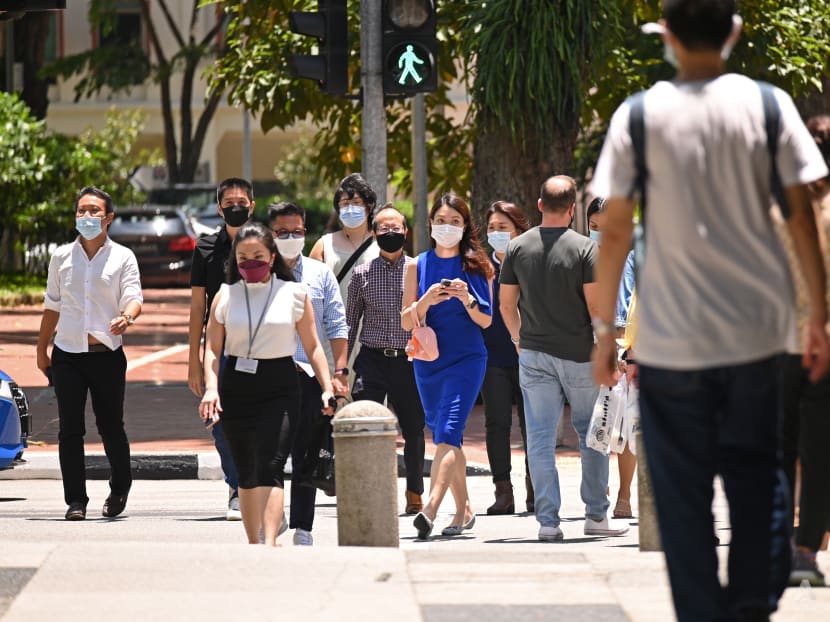Commentary: Unvaccinated populations fuel the emergence of COVID-19 variants
More of the coronavirus can multiply within unvaccinated people, meaning a higher chance of mutation, says Duke-NUS Medical School’s Professor Lok Shee Mei.

People wearing protective face masks cross the road at Pickering Street in Singapore on Sep 6, 2021. (File photo: CNA/Gaya Chandramohan)
SINGAPORE: Viruses are essentially parasites.
In order to multiply, they must get into a mammalian cell and hijack the host machineries for reproduction. In the case of SARS-CoV-2, the virus responsible for COVID, humans serve as vessels for it to multiply.
SARS-CoV-2 is an RNA virus. As the virus multiplies its viral genome inside cells, it generates random mutations due to the mistakes it makes when copying its genome. Most RNA viruses lack the ability to check and correct errors or proofreading skills, and thus have fast rate of mutation.
Coronavirus has some “light” proofreading mechanism compared with other RNA viruses such as influenza virus and HIV, the causative agents of flu and AIDS respectively, and therefore mutates slower.
Nonetheless, we are seeing a slew of SARS-CoV-2 mutants generated since its outbreak two years ago. The generation of mutants gives an opportunity for the virus to adapt and change, making them harder to exterminate.
RACE BETWEEN VARIANTS
When SARS-CoV-2 virus goes through numerous cycles of multiplying, mutations accumulate, and variants arise. Different mutations in different variants can be either detrimental, neutral or advantageous to their survival.
Then the race between variants begins. Which will reign supreme depends on their characteristics and factors such as how fast they can infect a person, how transmissible they are and how they can overcome the hosts’ pre-existing immunity.
An example of the mutations advantageous to the survival of virus is the current SARS-CoV-2 Omicron variant, which is overtaking the Delta variant. It contains 50 mutations of which 36 are on the virus surface spike protein.
This spike protein plays an important role to allow virus to attach and infect cells. It is also the primary protein that several vaccines including the Pfizer and Moderna vaccines were based on.
Recently, a research group from the University of Hong Kong showed the Omicron variant can attach to the airway more efficiently but its ability to infect lung cells is poorer than Delta. This could explain why Omicron is more transmissible but is less lethal than Delta.
The mutations on the spike protein also coincide with the regions where the vaccine stimulated antibodies are binding to. Since the spike protein vaccines were designed by using previous SARS-CoV-2 variants, the immunity elicited by these vaccines have reduced capability in blocking Omicron infections.
That is how variants can partially overcome pre-existing immunity. Whether the virus will change into something more dangerous is still debatable as killing its host is not advantageous to the virus in the long run.
Thus far, the history of SARS-CoV-2 has developed in this sequence – from the original virus detected two years ago, to the Alpha variant (B117), the Beta variant (B1351), the Gamma variant, the Lambda variant, the Delta Variant and now the Omicron variant.
Gamma, Lambda and other less well-known variants did not lead to more outbreaks because they were very quickly taken over by other more transmissible variants.
Are COVID-19 vaccines still effective against new variants? And could these increase the risk of reinfection? Listen to the full conversation with Profs David Matchar and Gavin Smith on on CNA's Heart of the Matter podcast.
UNVACCINATED POPULATIONS FUEL VARIANTS
Do the unvaccinated populations fuel the emergence of SARS-CoV-2 variants?
The consensus among the scientific community is yes, they likely do. Unvaccinated people have less protection from the SARS-CoV-2 virus and thus would allow more of the virus to multiply within them.
In comparison, a fully vaccinated individual has a high level of immunity and therefore presents a more hostile environment for the virus to multiply.
The higher rate of virus multiplication in the unvaccinated is likely to result in more possible mutations of the virus, resulting in the emergence of a larger number of variants in unvaccinated than vaccinated people.
The variants produced by unvaccinated people can then spread to the vaccinated. Variants that can overcome the immunity in vaccinated individuals can also emerge in this way.
The latest Omicron variant, seems to have mutations that can partially escape from the immunity elicited by the Pfizer and Moderna vaccines, suggesting that vaccinated people may also serve as a conduit for the emergence of new variants.
Although it is comforting to see South African countries reporting a milder disease caused by Omicron in their generally young population, its high transmissibility indicates a large proportion of the population will be infected. This could still overwhelm their health systems.
VACCINATIONS PROTECT YOU AND YOUR LOVED ONES
While people who received the current Pfizer and Moderna vaccines have reduced protection against infection by the Omicron variant compared to the earlier variants, its protection against serious disease developing is still very high.
Therefore, it is important and prudent to get vaccinated. A booster shot can increase antibody levels and bring up waning immunity level which will further improve protection against Omicron.
Other than Pfizer and Moderna vaccines, there is a growing body of preliminary data showing that Omicron is able to escape from immunity induced by other vaccines such as those from Sinovac, AstraZeneca and J&J.
This is very concerning because if the Omicron can infect and multiply in vaccinated individuals efficiently, this might enhance further selection of mutants that can escape from the current vaccines, which indicates that it is about time to update our vaccine design.
Regardless, vaccinations protect against serious diseases and death, especially in young and healthy people, infection of these individuals with the newly emerged variant will update the immune system with the latest virus version, thus protecting the population down the road.
But this is not to encourage people to have virus parties, since there’s no crystal ball to confidently predict the outcome of the disease for a particular individual.
These past two years have been a battle between the SARS-CoV-2 virus and humans using our intelligence, immunity and discipline. Vaccines, therapeutic antibodies and drugs have been invented to overcome the virus. People have also been practising mask wearing and social distancing.
In turn, SARS-CoV-2 is mutating to increase its transmissibility and overcome vaccines and drugs.
COVID-19 is likely here to stay. If that happens, we will have to keep updating our vaccines and develop effective drugs and treatments to combat the new virus variants.
Unless SARS-CoV-2 evolves to become a mild disease-causing virus – much like the common cold viruses, we may have to keep up with the battle and stay vigilant.
For now, it’s probably wise to go for vaccinations including the booster shots, and continue to practise social responsibility to protect our young and old.
Let’s all continue to follow the science in formulating our COVID-19 strategies as we navigate the challenges of living with the virus.
Professor Lok Shee Mei is from the Emerging Infectious Diseases Programme of Duke-NUS Medical School and NUS Provost’s Chair Professor.
BOOKMARK THIS: Our comprehensive coverage of the COVID-19 pandemic and its developments
Download our app or subscribe to our Telegram channel for the latest updates on the coronavirus pandemic: https://cna.asia/telegram











